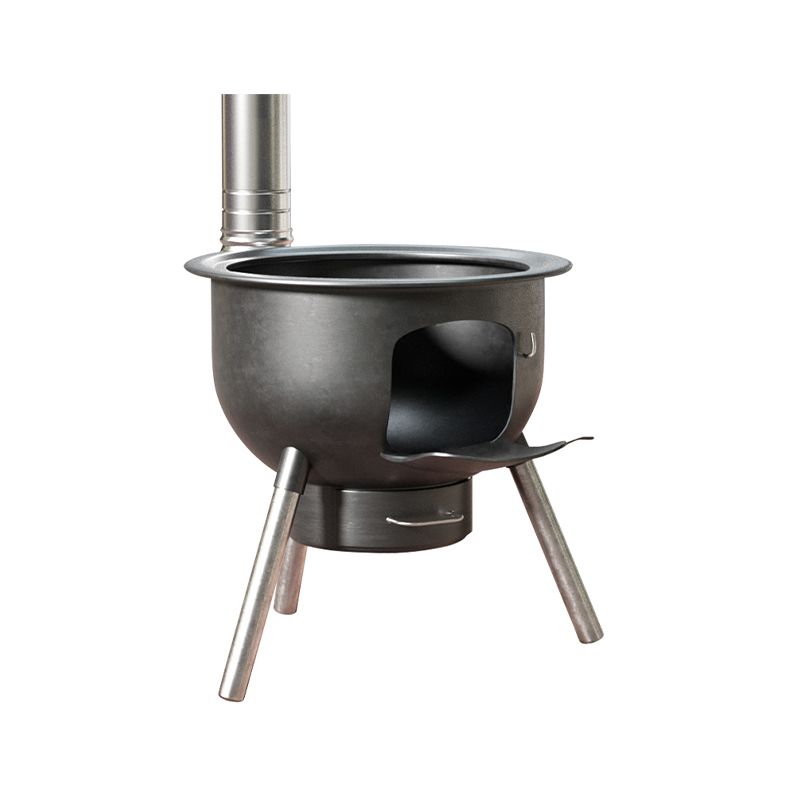How can the secondary air intake system of an open-door heating stove optimize combustion completeness?
Release Time : 2025-11-06
The secondary air intake system of an open-door heating stove is a core component for improving combustion efficiency, and its design directly affects the mixing effect of fuel and oxygen and the completeness of combustion. Optimizing this system requires addressing four aspects: airflow distribution, airflow organization, adaptation to combustion stages, and equipment coordination. High-efficiency combustion can be achieved through dynamic adjustment and structural improvements.
The core function of the secondary air intake system in an open-door heating stove is to supplement oxygen in the later stages of fuel combustion, ensuring that unburned combustibles react completely. In traditional designs, secondary air is often injected directly into the furnace through independent ducts, but uneven airflow distribution can easily lead to localized oxygen deficiency or flame deflection. One optimization approach is to adopt stratified air supply technology, dividing the secondary air into upper and lower layers or multiple streams. The opening of the upper damper is appropriately increased to enhance upper combustion, while the lower damper is moderately closed to avoid scouring the fuel layer, forming a "strong upper, stable lower" airflow structure that improves combustion efficiency and reduces fuel splashing.
Improvements in airflow organization must be combined with the characteristics of the furnace structure. For long furnaces, rectangular nozzles extend the airflow range more effectively than circular nozzles, ensuring secondary air covers the entire combustion zone. In short furnaces or when secondary air is introduced from both the front and rear walls, circular nozzles reduce dead zones. The nozzle height is typically 1.5 to 2 meters higher than the fuel bed, with an inclination angle controlled between 10° and 30° to prevent direct airflow impact on the fuel bed, which could cause dust generation, and to prevent incomplete combustion due to an excessively high combustion center. When secondary air is introduced from both the front and rear walls simultaneously, different injection angles must be designed to avoid airflow collisions and weaken the mixing effect.
Precise adaptation during the combustion stage is crucial for optimization. In the initial stage of fuel ignition, primary air provides the main oxygen; premature introduction of secondary air will lower the furnace temperature and inhibit combustion stability. Once the fuel enters the burnout stage, secondary air needs to rapidly replenish oxygen; at this point, the damper opening should be increased and the air velocity increased. Experiments show that the secondary air velocity needs to be more than twice that of the primary air velocity to penetrate the viscous layer of the high-temperature flame and enhance the contact efficiency between air and coke particles. Some designs utilize swirl blades to create an oxidizing atmosphere in the secondary airflow, enveloping the pulverized coal. This establishes a fuel-rich, oxygen-deficient environment in the flame core, suppressing nitrogen oxide formation while maintaining combustion efficiency.
The coordinated optimization of the open-door heating stove requires consideration of the linkage between the forced draft fan and the combustion control system. Secondary air pressure is adjusted via the forced draft fan blade angle and induced draft fan stator blades, forming a closed-loop control with the furnace pressure difference. When the boiler load changes, the system must automatically adjust the secondary air damper opening; for example, during load reduction, the fan output is gradually reduced to maintain the superheater outlet oxygen content between 3% and 5%. If the oxygen content deviation exceeds 0.5%, an automatic correction mechanism must be triggered to prevent combustion efficiency loss due to oxygen deficiency or heat loss due to excess air.
Material and process improvements can further enhance system performance. A Junkers three-compartment air preheater is used, preheating the secondary air in compartments to achieve air temperatures between 100°C and 300°C, reducing fuel heat absorption requirements and increasing combustion rate. Adjustable baffles are installed within the air box to dynamically distribute airflow to each nozzle, adapting to the combustion requirements of different coal types. For example, when burning low-volatile coal, the preheating temperature needs to be increased and the primary air velocity reduced. In this case, secondary air needs to be introduced earlier to stabilize the ignition point. When burning high-volatile coal, the secondary air introduction time needs to be delayed to prevent slagging or burnout of the burner.
During long-term operation, the secondary air intake system needs to be maintained in conjunction with soot blowing and oxygen monitoring. Regularly clean the ash buildup in the air preheater and control the inlet flue gas temperature within a reasonable range to avoid insufficient secondary air temperature due to decreased heat transfer efficiency. Optimize the air-coal ratio using real-time data feedback from the oxygen sensor to ensure low carbon content in fly ash. These measures together constitute a closed-loop control system, enabling the open-door heating stove to maintain efficient and stable operation even under complex conditions.




